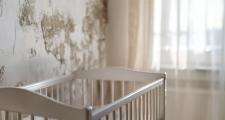Social workers forced to remove children from damp, vermin-infested houses

More than a fifth of social workers have seen removals of children in the past three years where “unsafe or inappropriate” housing was a key factor, new SWU research reveals.
A survey of nearly 2,300 social workers carried out in October 2024 showed 78 per cent of social workers agreed housing conditions were a major concern for the people they support, and a third (36 per cent) reported an increase in the number of people living in unsafe housing over the last three years.
Conditions reported included serious maintenance issues, mould, damp, insect or vermin infestations and chronic overcrowding.
The survey reveals housing issues are particularly acute in the north east, London and Wales. Four out of ten social workers in these areas said poor housing was “a serious and growing concern” and the numbers of families living in unsafe conditions had increased.
In some cases, the condition of homes was serious enough to trigger an investigation. In other cases it was one of many factors, including poverty, leading to the need for intervention.
A social worker in Wales responding to the survey said: "Had to remove several children from houses covered in black mould… Housing department took no accountability for it being unsuitable and tried to blame tenant. The mould was chronic and led to health conditions for children and parents.”
Another in the north east of England reported: "Private landlords are especially bad. One removal saw dangerous health and safety conditions, no gas/electricity, holes in ceilings/floors. There has also been a council property with damp/mould, [with] overcrowded housing impacting on routines in the household, cluttered homes, spider and rat infestations.”
John McGowan, general secretary of SWU, said: "Removal of a child from their family is always a last resort, but sadly when conditions become dangerous action has to be taken.
"The country’s poor housing stock poses a danger to the wellbeing and development of children and poses a risk to the health of many adults with pre-existing health conditions.”
The survey has prompted concern among NHS workers who are already reporting serious health consequences for children living in unsafe housing.
Amaran Uthayakumar-Cumarasamy, an NHS children's doctor based in south Yorkshire, said: “Some of the most acute harms of the UK’s unsafe, unaffordable and insecure housing are shouldered by our most disadvantaged children and young people.
“Increasingly, children's health professionals across the UK are witnessing cases of respiratory illness, undernutrition and worsening mental health all linked to undignified housing circumstances.
“Unfit, unsafe and expensive housing continues to severely impact their educational attainment, social health and life chances.”
SWU is calling for immediate government action, including investment in housing upgrades and improved insulation, and a 'properly funded' £13.2 billion Warm Homes Plan.
McGowan added: "We also support calls from across the sector to ensure local authorities and housing providers are properly resourced to carry out their duties.
“Ministers must own up to the fact that it is only the government that can provide the funding to reverse the decline in public services and ensure the most vulnerable get the support they need.”
Simon Francis, coordinator of the End Fuel Poverty Coalition, backed calls for a Warm Homes Plan, adding: “Until these reforms are delivered, ministers must not forget about the millions of people suffering in cold damp homes – they should provide enough support to ensure that everyone is able to stay warm every winter.”
And Matthew Scott, senior policy officer at the Chartered Institute of Housing, added: "Warm, safe homes are the cornerstone of our health, but this research demonstrates the life changing impact housing can have on children's wellbeing.
“The government should seize the opportunity to reverse the cycle of underinvesting in housing quality, so every child has a safe, secure home.”
